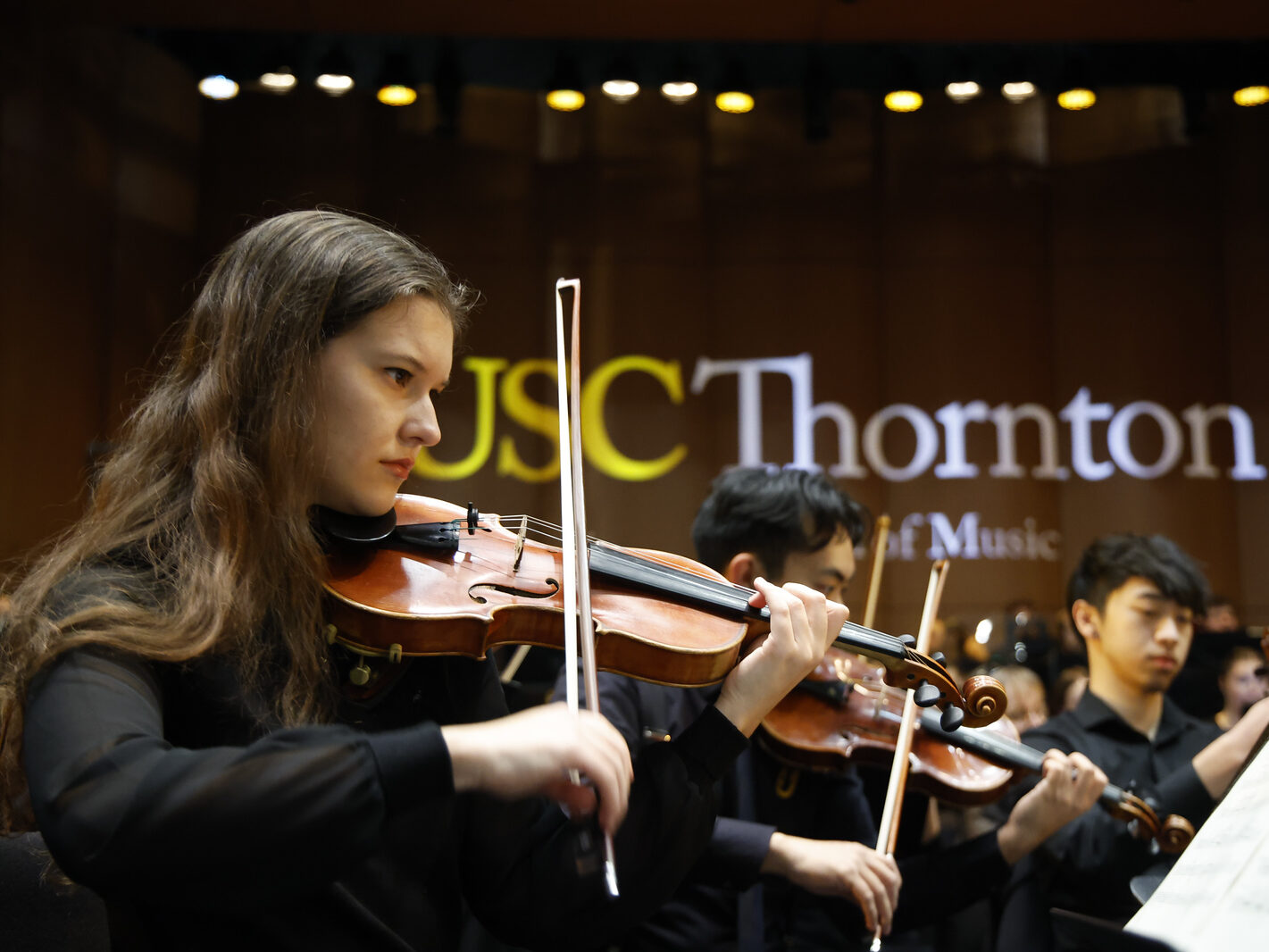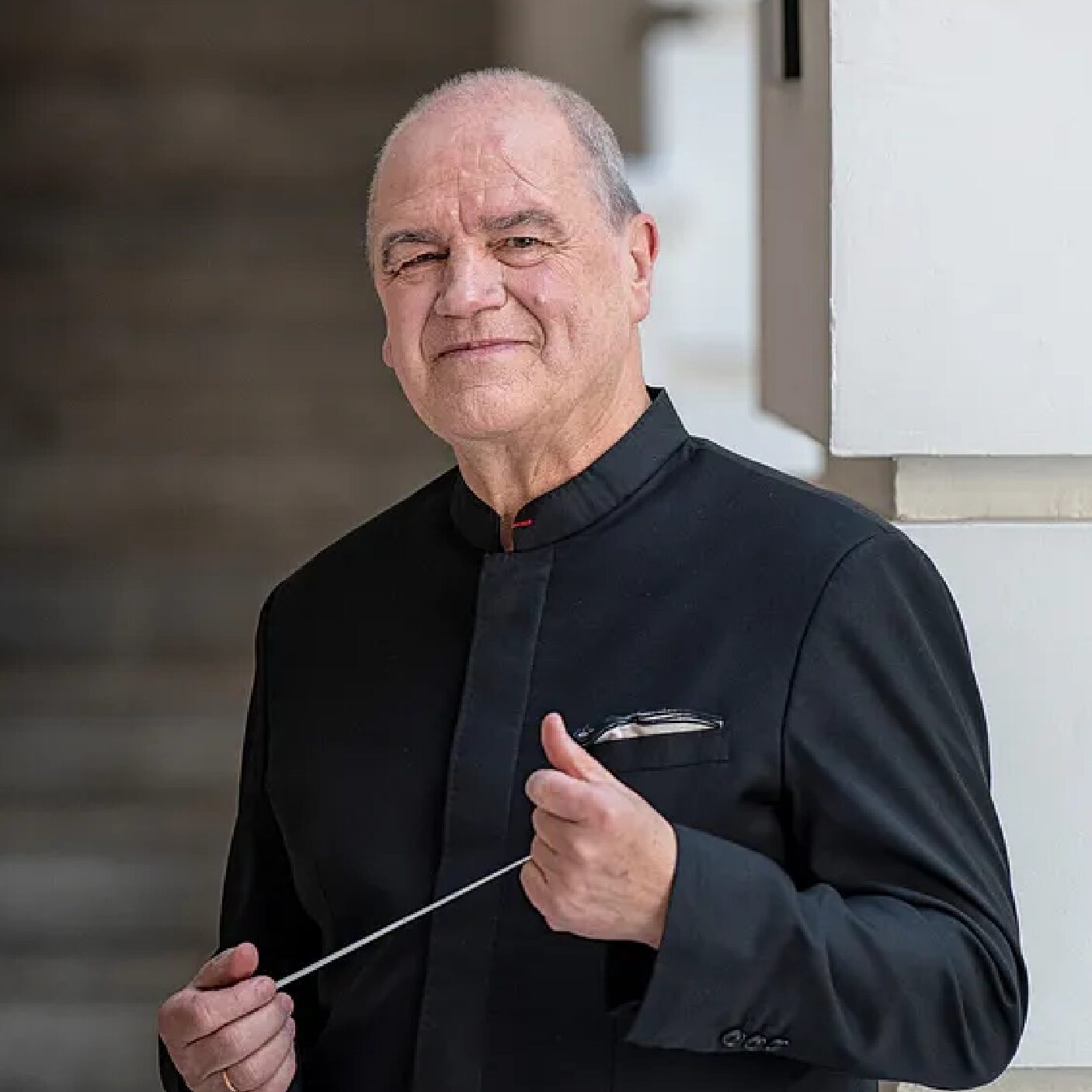
Concert Programs
USC Thornton Symphony concert program
Guest conductor Hans Graf leads the USC Thornton Symphony in the opening concert of the Spring 2024 semester.
Hans Graf is a distinguished Austrian conductor known for his wide range of repertoire and creative programming. He currently serves as music director for the Singapore Symphony Orchestra and has performed with countless orchestras around the world.
The program features Johann Strauss II’s Die Fledermaus Overture and Johannes Brahms’ Symphony No. 2 in D Major, op. 73.

Program
Die Fledermaus Overture
Johann Strauss II
(1825-1899)
Symphony No. 2 in D Major, op. 73
I. “Allegro non troppo”
II. “Adagio non troppo”
III. “Allegretto grazioso (Quasi andantino)”
IV. “Allegro con spirito”
Johannes Brahms
(1833-1897)
Program Notes
Die Fledermaus Overture
Johann Strauss II
(1874)
Johann Strauss II’s operetta Die Fledermaus (“The Bat”) is a sparkling gem of the Viennese operatic tradition. Die Fledermaus Overture serves as a brilliant prelude to the operetta’s sparkling narrative, encapsulating the essence of Viennese charm and revelry. Composed in 1874, the overture showcases his exceptional talent for crafting vibrant and engaging orchestral works.
Die Fledermaus, is a humorous operetta that revolves around a series of mistaken identities, elaborate practical jokes, and the festive atmosphere of a grand Viennese party. The plot is set in motion when Gabriel von Eisenstein is granted a brief reprieve from his impending prison sentence to attend a party hosted by Prince Orlofsky. Unbeknownst to him, his wife, Rosalinde, also attends the same event in disguise. The story unfolds with a mix of disguises, flirtations, and comedic situations, ultimately leading to a jubilant and celebratory conclusion.
The lively and rhythmic opening reflects the excitement and anticipation of a grand social event, mirroring the atmosphere of the party central to the plot. The waltz motifs, which are characteristic of Strauss’s style, evoke the elegance and grace of Viennese ballroom dance, a prominent feature in the operetta. Additionally, playful and whimsical themes in the overture hint at the mischievous elements and humorous situations that unfold throughout the story.
Johann Strauss II’s Die Fledermaus Overture serves as a captivating overture that encapsulates the spirit of 19th-century Vienna. Its lively dance rhythms, playful themes, and brilliant orchestration make it a timeless and exhilarating prelude to the operetta’s enchanting tale. As the orchestra paints a vivid musical portrait, the overture invites audiences to immerse themselves in the delightful world of Die Fledermaus, where laughter, romance, and celebration abound.
Marcos Salgado, BM ’27
Symphony No. 2 in D Major, op. 73
Johannes Brahms
(1877)
Bach, Beethoven, and Brahms- “The Three B’s” of classical music greatness, held above other composers as pinnacles of the craft. Brahms would certainly be humbled to be included on a list with Beethoven, his ardent admirer to the point that Brahms felt it difficult to compose outside of Beethoven’s shadow. Seeking to find his own path in the symphonic genre, Brahms labored over his first symphony for around twenty years. Even after decades of waiting, comparisons to Beethoven couldn’t be escaped- with the symphony referred to as “Beethoven’s Tenth” in its time. This was partially by design, with many references to Beethoven’s Fifth and Ninth symphonies woven into the piece.
In contrast, the second symphony abandons the Beethoven comparisons and agonized quality in favor of something much lighter. He completed the second symphony just a year after the first, composed in mere months while on vacation in northern Austria. The work opens with a sunny horn call, followed by what is commonly referred to as the “Brahms Lullaby.” By mixing idyllic melodies such as the Lullaby with dramatic, minor-mode sections, Brahms complicates what initially presents itself as a purely pastoral symphony. Angst emerges in the second movement, but the celli’s initially stormy melody soon turns into sweeping lyricism. The third movement departs from Brahms’ musically conservative tendencies, avoiding classical expectations of a paired dance movement, like Beethoven’s Scherzi and Trios. Instead, the opening oboe melody carries throughout the movement in a form more closely resembling his contemporary Tchaikovsky than his beloved Beethoven. Following the restrained third movement, the fourth erupts into a joyous event after building anticipation throughout the pianissimo opening. This conclusion is triumphant, Brahms surely feeling relief after the work’s quick completion in comparison to his first symphony.
After the tortuous wait for the first symphony, it is hard to believe that Brahms could compose a second symphony at all, let alone a third and fourth. While Brahms’ symphonic output is limited compared to his idol Beethoven, his efforts are well worthy of a spot with Bach and Beethoven in “The Three B’s.”
Lillian Young, MM ’25
The Blue Danube Waltz, op. 314
Johann Strauss II
(1866)
Johann Strauss II, born on October 25, 1825, in Vienna, Austria, was a prolific and influential composer of the 19th century. Following in the footsteps of his father, Johann Strauss I, a renowned composer and bandleader, young Johann initially resisted a musical career, seeking a profession in banking. However, the irresistible allure of music eventually won him over.
Strauss quickly rose to prominence, captivating Vienna with his enchanting compositions and conducting. His career was marked by a series of iconic waltzes, polkas, and marches. Notable among his timeless creations are The Blue Danube Waltz, Tales from the Vienna Woods, and the operetta Die Fledermaus.
Known as the “Waltz King,” he composed The Blue Danube Waltz (An der schönen blauen Donau, op. 314) in 1866. This masterpiece has become synonymous with the style and charm of Viennese waltz tradition, captivating audiences worldwide with its timeless beauty.
Strauss conceived The Blue Danube as a celebratory piece, capturing the spirit of 19th-century Vienna. The waltz opens with a delicate introduction that sets the stage for the enchanting melodies to come. The main theme, introduced by the strings, is a sublime and graceful melody that evokes the scenic beauty of the Danube River. Strauss skillfully incorporates various dance episodes, creating a musical journey that mirrors the lively atmosphere of a Viennese ball.
One of the most iconic moments in the waltz is the famous second waltz refrain, characterized by soaring strings and a sense of refined elegance. This section has transcended its original dance context and has become one of the most recognizable and cherished melodies in classical music.
The success of The Blue Danube lies not only in its captivating melodies but also in Strauss’s brilliant orchestration. The composer utilizes a rich palette of instruments, from lush strings to playful woodwinds and triumphant brass, creating a symphonic tapestry that captures the imagination.
The Blue Danube Waltz remains a staple in the classical repertoire and has been embraced in popular culture, featured in films, advertisements, and various artistic endeavors. Its enduring popularity attests to the universal appeal of Strauss’s melodic genius and the waltz form.
Marcos Salgado, BM ’27
About the Artists
Hans Graf

Music Director, Singapore Symphony Orchestra
Principal Guest Conductor, Aalborg Symphony Orchestra
Music Director Emeritus, Houston Symphony Orchestra
Known for his wide range of repertoire and creative programming, the distinguished Austrian conductor Hans Graf is one of today’s most highly respected and experienced musicians. With Hans Graf, “a brave new world of music-making under inspired direction” (The Straits Times) began at the Singapore Symphony Orchestra, where he was unanimously appointed Chief Conductor from the 2020/21 season, and then Music Director from the 2022/23 season.
Maestro Graf also currently holds the title of Principal Guest Conductor of the Aalborg Symphony Orchestra of Denmark and formerly served as Music Director of the Houston Symphony Orchestra, the Calgary Philharmonic Orchestra, L’Orchestre National Bordeaux Aquitaine, The Basque National Orchestra Euskadi and the Mozarteum Orchestra Salzburg.
He has appeared with nearly all major orchestras of the United States including the Boston Symphony, the Cleveland Orchestra, the Detroit Symphony, the Los Angeles Philharmonic, the New York Philharmonic, the Philadelphia Orchestra, the San Francisco Symphony, the Pittsburgh Symphony, the St. Louis Symphony, the Dallas Symphony, the Indianapolis Symphony, the Minnesota Orchestra and the St. Paul Chamber Orchestra; and in Canada with Orchestre Symphonique de Montreal, the Toronto Symphony Orchestra, the Vancouver Symphony Orchestra and the National Arts Centre Orchestra Ottawa.
In Europe, Graf has conducted the Vienna Philharmonic Orchestra, the Vienna Symphony, the Tonkuenstler Orchestra of Austria, in Germany the Bavarian Radio Symphony Orchestra, the Leipzig Gewandhausorchester, the DSO Berlin, the Dresden Philharmonic, the Konzerthaus Rochester Berlin and many others; in Holland the Royal Concertgebouw Orchestra Amsterdam, the Rotterdam Philharmonic, the Netherlands Radio Philharmonic, and the Residentie Orchestra; in Belgium the Orchestre National de Belgique and the Antwerp Symphony Orchestra, in Scandinavia the Danish National Radio Orchestra, the Oslo Symphony, the Royal Stockholm Philharmonic, the Finnish National Radio Orchestra, and many others in the United Kingdom the London Symphony Orchestra, the Royal Philharmonic Orchestra, the Hallé Orchestra, the London Philharmonic Orchestra, and many others; in Russia the St Petersburg Philharmonic and Russian National Orchestra, in Eastern Europe the Budapest Festival Orchestra and still so many others. In the Far East and Southern Hemispheres Graf is a regular guest with the Sydney Symphony, the Melbourne Symphony, the Auckland Philharmonia, the Seoul Philharmonic and the KBS Orchestra Seoul, the Hong Kong and Malaysian Philharmonic Orchestras and the National Symphony Orchestra of Taiwan.
A frequent conductor at the Salzburg Festival since 1983, Graf has also participated in the prestigious festivals of Maggio Musicale, Bregenz, Aix-en-Provence in Europe, and in the US, the Tanglewood, Blossom, Aspen, Grant Park and the Bravo! Vail Valley Music Festivals.
In the world of opera, Maestro Graf has led many performances at the Vienna State Opera and in various of the opera houses of Munich, Berlin, Paris and Rome, among others. More recent productions include Wagner’s Parsifal in Zurich and Mussorgsky’s Boris Godunov in Strasbourg. In 2014 he was awarded the Österreichischer Musiktheaterpreis for Richard Strauss’s Die Feuersnot at the famed Vienna Volksoper, where he returned in 2021 to lead Richard Strauss’ beloved Der Rosenkavalier.
Hans Graf’s extensive discography is found on the EMI, Orfeo, CBC, Erato, Capriccio and JVC labels and includes all the symphonies of Mozart and Schubert, the complete orchestral works of Henri Dutilleux (recorded under the composer’s supervision), and the world-premiere recording of Zemlinsky’s Es war einmal. Graf’s semi-staged production of Berg’s Wozzeck with the Houston Symphony won both the GRAMMY and ECHO Klassik awards for best opera recording.
Born near Linz in 1949, Graf studied conducting with Franco Ferrara, Sergiu Celibidache and Arvid Jansons. He is Professor Emeritus for Orchestral Conducting at the Universität Mozarteum in Salzburg. For his services to music, he was awarded the Chevalier de l’Ordre de la Légion d’Honneur by the French government and the Grand Decoration of Honour in Gold from the Republic of Austria.
Ensemble
Violin I
Soomi Park, concertmaster
Veronika Manchur
Kaiyuan Wu
Anna Renton
Sarah Yoo
Ariana O’Connell
Eric Cheng
Marena Miki
Sofia Llacer Chamberlain
Maya Masaoka
Emily Hsu
Laura Gamboa
Violin II
Sarah Beth Overcash, principal
Qiaorong Ma
Robert Henson
Diana Dawydchak
Agatha Blevin
Yu Gong
Abigail Park
Sara Yamada
Bradley Adam Bascon
Viola
Nicolas Valencia, principal
Sunwoo Lee
Prosper Luchart
Daniel Miles
Yu-Chen Yang
Katherine Brown
Cecile McNeill
Jay Maldonado
Gloria Choi
Ziyan Zeng
Cello
Ji Sun Jung, principal
Yuqi Wang
Jeremy Tai
Joseph Kim
Samuel Guevara
Maddie Bolin
Taewon Park
Celilo Swain
Bass
Eric Windmeier, principal
Ethan Moffitt
Lillian Young
Zach Hislop
Julien Henry
Sarah Wager
Harp
Mischael Jones
* principal on Strauss
+ principal on Brahms
Flute
Jenny An*
Celine Chen
David Ramirez+
Gaby Beltran Garcia*
Piccolo
David Ramirez
Jenny An
Oboe
Lauren Breen*+
Monica Song
Clarinet
Chanul Kim*
Louis Milne
Melissa Frisch+
Anders Peterson
Bassoon
Taki Salameh*
Chris Lee
Cal Lieungh+
Ben Richard
Horn
Lauren Goff*
Evelyn Webber
Reese Romero
Abraham Murillo
Rebecca Baron
Jean Smith+
Steven Phan
Trumpet
Jazzmine Van Veld*
Ryan Fuhrman*
EJ Miranda+
Kobina Sampson-Davis
Trombone
Sean Cooney+
Raymundo Vizcarra*
Bass Trombone
Kevin Truong
Tuba
Patrick Zhang
Timpani
Preston Spisak*+
Percussion
David Lee*
Marcos Salgado
Leigh Wilson